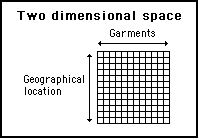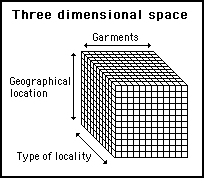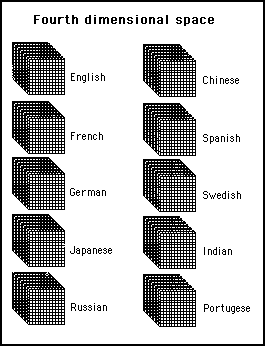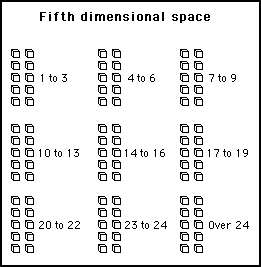
Chapter 9
A formatted people space
Scaling up
The hypothetical example described above assumes a limited number of rag merchants and garment buyers. The number of rag merchants in each garment space is assumed to be quite modest, such that it would be possible for buyers in the space to easily contact all of them to sort out who is the best to deal with.
However, if this were extended world wide, to include every rag merchant on the planet and everyone in the world is allowed to join in, the system would soon become overcrowded. There might be hundreds of rag merchants in the garment spaces and it would be very difficult for buyers to choose between them.
To make life easier, it might be sensible if each garment space were divided up further. Perhaps divided by geographic location, according to where rag merchants were geographically situated. This would reduce the numbers in any particular space and at the same time ensure that buyers didn't waste time trying to deal with merchants whose warehouses were further away from them than they were prepared to travel.
By splitting up the garment spaces in this way the total space would take the form of a two dimensional grid, as shown in figure 9.6. In this diagram, there are twelve garment spaces (columns) divided up into twelve geographic locations (rows). This creates 144 different spaces where rag merchants and buyers can meet.
In each of these areas, there will be fewer people, but, they will each know that they are interested in the same kind of garment and are geographically close to each other.

Figure 9.6
Contact places, where rag merchants and buyers meet, can be spread over a two dimensional grid to increase the efficiency of finding the best contacts
Even though there might be a large number of garment categories and a large number of geographic locations, some of the contact areas might still be over crowded. This problem is easily overcome by adding yet another dimension to the overall meeting space.
Let's say that the type of locality, where the rag merchant's warehouse is situated, is also an important buying consideration. Some buyers might prefer the unsorted garments to be drawn from one type of locality, while others might prefer another. This distinction could provide a third dimension to divide up the total meeting space. This is illustrated in figure 9.7 where by adding twelve categories of locality, the total number of possible contact points is increased from the two dimensional number of 144 to a three dimensional number 1,728.

Figure 9.7
By adding a third dimension, the possible contact places have increased from 144 to 1,728
Adding this third dimension, not only reduces the over crowding, but, also ensures that buyers and sellers are more likely to be compatible. In this three dimensional space, every buyer will know that the rag merchants, who will be in a particular meeting area they choose, will not only be sorting the type of garments they need and be geographically near to them, they will also be drawing stock from the right kind of locality.
Imagine now that there are thousands of different rag merchants of many different nationalities and the customer only speaks one language. They would obviously prefer to deal with only the rag merchants that they can speak with. This can be accommodated by adding a fourth dimension, which will create a different three dimensional space for every language. This four dimensional space is illustrated in figure 9.8, where the three dimensional space is recreated ten times: each to cater for a different language that the merchants and customers might prefer to speak.

Figure 9.8
By adding a fourth dimension, customer can go to the spaces where they'll meet only the merchants who speak their language
This fourth dimension will have the effect of increasing the number of different possible meeting places to 17,280. This will greatly reduce the effect of over crowding and at the same time improve the compatibility of buyers and sellers.
There may be other preferences that a customer might have. If there are so many merchants that that there is still over crowding, a new dimension can be added for every important category. Figure 9.9 shows a fifth dimension being added to allow the customer to also choose the size of the merchants they deal with:

Figure 9.9
A fifth dimension might separate out the rag merchants by the number of sorters they use, as well as by garments sorted, geographic location, type of locality and language spoken. In this diagram, it shows this fifth dimension as consisting of nine groups, each with ten, three dimensional areas
This fifth dimension will increase the number of different places a rag merchant or a buyer can establish a presence to 155,520. This may seem ludicrously excessive for finding rag merchants, but, this is only a simplistic example used to explain the principle. What is of interest is that this same principle can be applied to areas where there are millions of people involved. Then, 155,520 different possible meeting places might seem very sensible indeed.
These diagrams graphically illustrate how the parameters associated with choice can be used to format a people space to increase the efficiency of finding suitable contacts. The significance of this model cannot be underestimated. This is a powerful way to divide up a super large population in order to seek out valuable contacts for information or help.